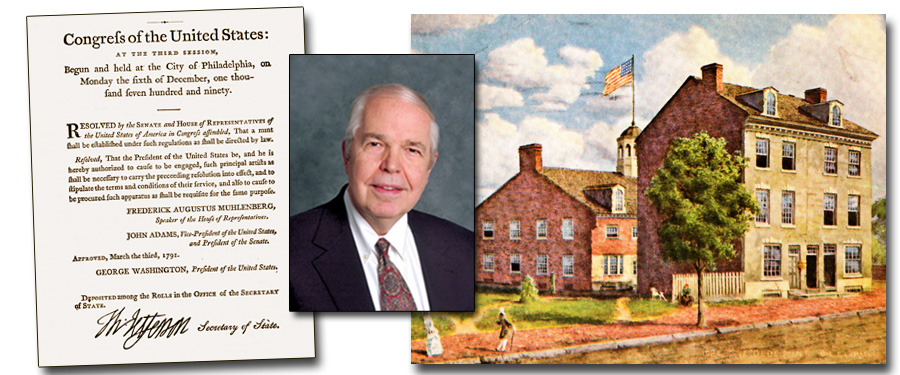
One of the most important figures in American numismatics is James Mease, M.D., of Philadelphia. In the early 19th century he was the first to publish important studies on the subject. Although he is known to and has been discussed in print by such modern scholars as David F. Fanning, Eric P. Newman, and Joel Orosz, he is unknown to perhaps 99% of numismatists active today. A few years ago I proposed Mease as a candidate for the American Numismatic Association Hall of Fame, but with no result as it seems that others submitting nominations had never heard of him.
David F. Fanning in this Spring 2004 Price List II gave this synopsis of Mease:
“James Mease, M.D. (1771-1846) was a polymath who published on a number of different subjects, including medicine, geology, and history. He was well known as the editor of the Domestic Encyclopedia (1803-1804) and the Archives of Useful Knowledge (1811-1812). His Picture of Philadelphia (1811) is a foundational work of local history and contains the first useful description of the U.S. Mint operations.”
Mease collected coins, books, autographs, and prints among other specialties. The same can be said for most other important numismatists of the early and mid-19th centuries. Robert Gilmor, Jr., Mendes I. Cohen, and T. Harrison Garrett, among others, collected these as well. That was an era of learning and love of history. Today, most collectors have a narrow focus only on coins, and the art, history, and romance of their background is often overlooked.
In 1811 B. & T. Kite, 20 North Third Street, Philadelphia, published a 376-page book (!) by Mease, The Picture of Philadelphia, Giving and Account of Its Origin, Increase and Improvements in Arts, Sciences, Manufactures, Commerce, and Revenue, with a Compendious View of Its Societies, Literary, Benevolent, & Religious, Its Police—The Public Buildings—The Prison and Penitentiary System—Institutions, Monied and Civil—Museum. Pages 154 to 157 described the Mint, mostly reciting the provisions of the Mint Act of April 2, 1792, with specifications of coinage, but prefaced by the following:
“Previously to the passage of the law, by the federal government, for regulating the coins of the United States, much perplexity arose from the use of no less than four different currencies or rates, at which one species of coin was reckoned in the different parts of the union. Thus, in New Hampshire, Massachusetts, Maine, Rhode-Island, Connecticut, Vermont, Virginia, and Kentucky, the dollar was reckoned at six shillings; in New York and North Carolina, at eight shillings; in New Jersey, Pennsylvania, and Maryland, at seven shillings and sixpence. In Georgia and South Carolina, at four and eight pence.
“This subject had engaged the attention of the Congress of the old Confederation, and the present system of the coins, is formed upon the principles laid down in their resolve of 1786: by which the denominations of money of account, were required to be dollars, (the dollar being the unit) dismes or tenths, cents or hundredths, and mills or thousandths of a dollar. Nothing can be more simple or convenient than this decimal subdivision, and the terms are proper because they express the proportions which they are intended to designate. The dollar was wisely chosen, as it corresponded with the Spanish coin, with which we had been long familiar.
“In the year 1792, a law was passed by the general government for establishing a mint, and for regulating the coins of the United States: by this law, the following coins were to be struck…”
After the specifications of various coins this was given:
“At the first establishment of the Mint, great difficulties and embarrassments were experienced from a variety of causes; but time has overcome them all, and it is understood, that in some respects the process of striking is more complete than in most other countries, England excepted.
“The mode of hardening the dies is peculiar to the Mint, and is the discovery of the present assistant coiner, Mr. [Adam] Eckfeldt. The beauty of the coin of the United States is not inferior to that of any country in the world. There is a sharpness and cleanness of cut, not perceptible in those of either France or Spain.
“The annual expense of the Mint establishment amounts to about 20,000 dollars. On the second Monday in February, the commissioner of loans, the district judge, and attorney general, are required, by law, to attend at the Mint, for the purpose of having the coins assayed, which have been reserved, in order to ascertain whether the coins issued from the Mint, during the past year, are equal to the standard fixed by law. [This was known as the Assay Commission.]
Since the establishment of the Mint, there have been coined, of: Gold, to the amount of $82,763,597.50; Silver, $4,370,846.50; Copper, $214,977.21
“Total value of coinage to 1809, $88,349,421 21 which the sum of $3,712,488 has been issued during the last four years…
“The present officers are, Director, Robert Patterson. Treasurer, Benjamin Rush. Chief coiner, Henry Voight. Melter and refiner, Joseph Cloud. Assayer, Joseph Richardson. Engraver, Robert Scott [Scot].”
Not mentioned as he was not an officer was John Reich, assistant engraver who today is memorialized in the name of the John Reich Collectors Society, a group specializing in early silver coins, especially the Capped Bust design created by Reich.
Some highly important documents relating to James Mease, M.D., have been consigned to our auction to be held this autumn with the Whitman Coins & Collectibles Expo in Baltimore. Announcements will be forthcoming.





